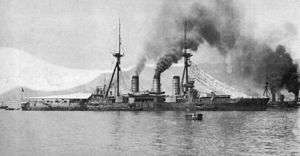Japanese battlecruiser Kurama
Kurama (鞍馬) was the final vessel of the two-ship Ibuki class of armored cruisers in the Imperial Japanese Navy. Kurama was named after Mount Kurama located north of Kyoto, Japan. On 28 August 1912, the Ibukis were re-classified as battlecruisers.
 Kurama | |
| History | |
|---|---|
| Name: | Kurama |
| Ordered: | 1904 Fiscal Year |
| Laid down: | 23 August 1905 |
| Launched: | 21 October 1907 |
| Commissioned: | 28 February 1911 |
| Stricken: | 20 September 1923 |
| Fate: | Scrapped, 20 September 1923 |
| General characteristics | |
| Class and type: | Ibuki-class battlecruiser |
| Displacement: | |
| Length: | 147.8 m (484 ft 11 in) |
| Beam: | 23 m (75 ft 6 in) |
| Draft: | 8 m (26 ft 3 in) |
| Installed power: | 22,500 ihp (16,780 kW) |
| Propulsion: | |
| Speed: | 21.25 kn (39.36 km/h; 24.45 mph) |
| Range: | 5,000 nmi (9,000 km; 6,000 mi) at 14 kn (26 km/h; 16 mph) |
| Complement: | 844 |
| Armament: |
|
| Armor: |
|
Background
Ibuki was designed with geared turbine engines which promised more power and hence, more speed; however, problems with these engines led Kurama to be completed with conventional vertical triple expansion reciprocating engines. Kurama was built at Yokosuka Naval Arsenal.
Service history
Shortly after commissioning, Kurama, with Admiral Hayao Shimamura on board, was sent on a voyage to Great Britain to attend the Coronation Fleet Review for King George V at Spithead on 25 June 1911.
Kurama served in World War I as part of Japan's contribution to the Allied war effort, protecting British merchant shipping in the South Pacific, and (together with the battlecruisers Kongō and Hiei ) supporting the landings to occupy German-held Caroline Islands and Mariana Islands. In the 1920s, she was assigned to the northern fleet, covering the landings of Japanese troops in Russia during the Siberian Intervention in support of White Russian forces.
After the war, Kurama fell victim to the Washington Naval Treaty and was scrapped.
References
- Evans, David (1979). Kaigun: Strategy, Tactics, and Technology in the Imperial Japanese Navy, 1887-1941. Naval Institute Press. ISBN 0-87021-192-7.
- Gardiner, Robert & Gray, Randal, eds. (1985). Conway's All the World's Fighting Ships: 1906–1921. Annapolis, Maryland: Naval Institute Press. ISBN 0-85177-245-5.
- Gibbs, Jay (2010). "Question 28/43: Japanese Ex-Naval Coast Defense Guns". Warship International. XLVII (3): 217–218. ISSN 0043-0374.
- Jentschura, Hansgeorg; Jung, Dieter & Mickel, Peter (1977). Warships of the Imperial Japanese Navy, 1869–1945. Annapolis, Maryland: United States Naval Institute. ISBN 0-87021-893-X.
- Lengerer, Hans & Ahlberg, Lars (2019). Capital Ships of the Imperial Japanese Navy 1868–1945: Ironclads, Battleships and Battle Cruisers: An Outline History of Their Design, Construction and Operations. Volume I: Armourclad Fusō to Kongō Class Battle Cruisers. Zagreb, Croatia: Despot Infinitus. ISBN 978-953-8218-26-2.